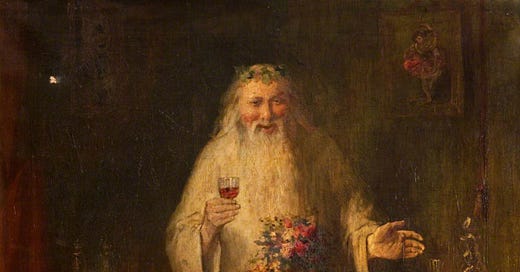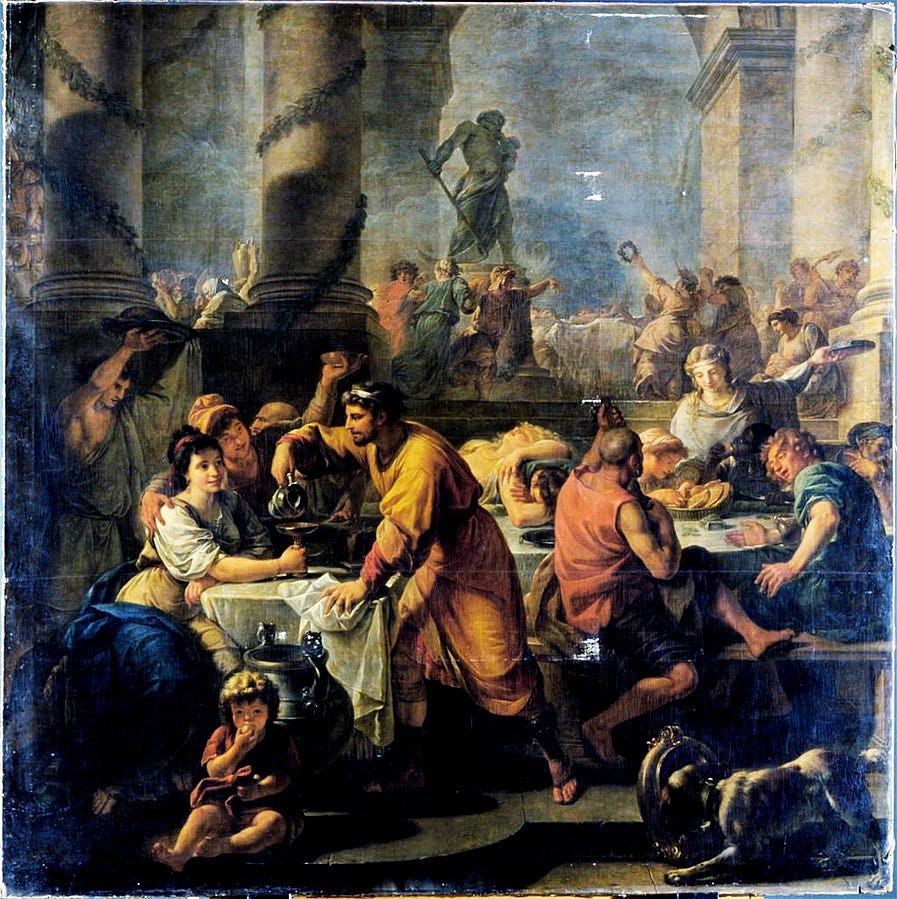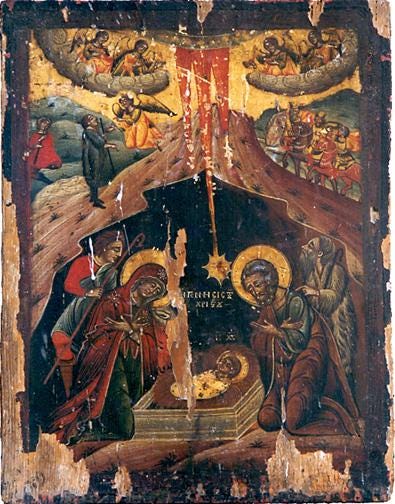A Brief History of Midwinter Celebrations
Or some reflections on why the British have a party in the depths of December
The Christmas Tree is decorated, the cards are written and posted (well ahead of the deadlines) and my carol playlist is on in the background. Now I am sufficiently in the seasonal mood it does start one thinking about the origins of the festival and its associated traditions. There is of course the temptation, especially in certain quarter of social media, to attempt to demonstrate how Christmas was stolen from the pagans. It’s a lovely myth, built as it is on romantic ideas of hard put upon rustics by some elite incomers and ignores how cultures shift and evolve.
Whether or not you celebrate Christmas, either as a religious or secular festival, there is something jolly about having a party when the nights are long and the weather is decidedly not at it’s best. As you will see this is something the British Isles have been doing for a very long time.
Early Archaeology
I could talk here about the various archaeological sites which seem to have an alignment to the Winter Solstice such as Newgrange in Ireland, Maes Howe, or Long Meg. The difficulty is that while we can for example see that there is a conjunction between the stones or openings and the solstice sunrise or sunset, it is just not possible to determine whether this was intended or what such an alignment could mean. Any interpretation of these sites is further complicated because they are rarely in their original configuration, many were rebuilt in the nineteenth and twentieth centuries, others were added to and modified in prehistory.
Solar alignments, while impressive from a technological perspective, of course utterly ignore the unpredictability of our weather. As many crowds gathered at Stonehenge every solstice can testify the sun is frequently hidden behind the grey drizzle. So while experts agree that some, but not all, of these ancient sites have a solar alignment we really do not know why, what the significance was or indeed what people did at these sites.

In recent years however archaeologists working in the Stonehenge landscape have found more tangible evidence that something important was happening around the winter solstice and that large numbers of people were involved. Close to Stonehenge itself there is a site known as Durrington Walls. Unlike Stonehenge this site appears to be more of a settlement, but one temporary in nature, together with two circular timber structures all contained within earthworks. In digging a number of large pits substantial quantities of pig bones were discovered. Judging by the age of the animals when they were slaughtered suggests that they were killed for a midwinter feast. If correct, this must make Durrington Walls the earliest recorded instance of the British eating too much (and undoubtedly drinking too much) in the middle of December1. Of course there is great speculation as to why hundreds of pigs were eaten, but the speculation is certainly intriguing.
Roman Winter Festivals
It is one of the great frustrations to the historian that as far as Bronze and Iron Age Britons are concerned they did not see the value in writing anything down. The little we do know was written by Roman historians who of course had their own agenda. Dwelling as they did in round houses, which leave only tantalising records, does not increase our knowledge any further. The alignment of the doors of round houses to the midwinter sun is likely to have been of more practical considerations to maximise daylight as opposed to religious or ceremonial significance. It is not until the arrival of the Romans that we get any written records of winter festivals, and of course these are unlikely to reflect the British traditions prior to the conquest.
Saturnalia
Of the various midwinter festivals celebrated by the Romans Saturnalia was possibly one of the longest enduring. It appears to have begun at some point in the late 5th Century BC and continued even after the official conversion of the Roman Empire in 323 AD. The festival itself was held in honour of Saturn, God of Agriculture and the Harvest.
The main religious ceremony was held on the the 17th December, typically followed by several days of parties and festivities. It was frequently celebrated by overturning all the normal rules of society so that masters served slaves, no criminals were convicted and importantly no wars started. It was traditional to exchange gifts at this time usually pottery figures or symbols of light. The satirist Lucian , in his work Saturnalia, had the God setting down the rules for his festival:
During my week the serious is banned no business allowed. Drinking and being drunk, noise and games and dice, appointing of kings and feasting of slaves, singing naked, clapping of tremulous hands, an occasional ducking of corked faces in icy water, –such are the functions over which I preside
The Kalendae or New Year
The Roman “New Year” on the 1st to 3rd January was sacred to Janus, the two faced God of transition, beginnings and endings. The Romans believed that beginnings were an omen for the remainder, so it was traditional to feast and exchange gifts to ensure a happy and prosperous year. The tradition of gift giving on New Years day endured in Britain, seemingly unbroken, until the 19th century.
Sol Invictus – the Invincible Sun
A third Roman festival around the midwinter period was held on 25th December, the date ascribed to the solstice at the time, this was known as Sol Invictus. There is a quote from Scriptor Syrus in the late 4th century AD which notes this was a popular festival among the pagans, however the festival itself was only decreed as such in 273 AD by Emperor Aurelian to be held every four years and celebrated with games. Before this time the solistice itself seems to have been a time of quiet contemplation.
It was a custom of the pagans to celebrate on the same 25 December the birthday of the Sun, at which they kindled lights in token of festivity. In these solemnities and revelries the Christians also took part. Accordingly when the doctors of the church perceived that the Christians had a leaning to his festival they took counsel and resolved that the true nativity should be solemnized on that day2.
Transition to Christianity
The quote above is one piece of evidence for the deliberate replacement of a pagan festival with the new Christian festival. It is certainly true that by 336 AD the birth of Christ was being celebrated on the 25th December, as the date of the Winter Solstice per the Roman calendar. Despite the festival of Sol Invictus being only a recent institution the links between Jesus and the Sun were obvious, so to the association with the birth of Christ and the increase in daylight hours.
Hence it is that He was born on the day which is the shortest in our earthly reckoning and from which subsequent days begin to increase in length. He, therefore, who bent low and lifted us up chose the shortest day, yet the one whence light begins to increase.
Saint Augustine, Sermon 192 3
However we need to be cautious if we are attempting to create a link between Christmas and a pre-Christian festival directly. While the Romans had several celebrations around the returning sun at midwinter it is more likely, at least in my opinion, that the early Church saw symbolic meaning in the “rebirth of the sun” as indicating the birth of the Son of God into the world, drawing new meaning from a pre-existing symbol. A similar parallel can be seen between the Yew tree, sacred to the Druids, but adopted by early British Christians due to both its long lifespan and evergreen leaves reminding them of the eternity of life in Christ.
Literary Sources
Naturally the transition to Christianity was not a simple or singular event, traditions did persist and to understand whether any of our present day traditions do indeed have a much longer history than the birth in Bethlehem we need to examine the various literary sources which, although written down much later, may give us some hints as to what our pre-Roman and pre-Christian forebears were doing at midwinter:
The Ulster Cycle, written about 200 years after the end of Irish Paganism, makes no mention of a midwinter festival, but rather those at the beginning of the seasons;
St Patrick, in the 5th century AD denounced those in Ireland who adored the sun;
Bede in c730 AD writes about Modranicht or Mother Night on the 24th of December where people kept watch with religious rites although frustratingly he does not mention what these might be4;
Yule as a festival makes its appearance under Danish rule in the 11th Century,5 there is doubt over whether the name was originally attached to a midwinter festival which preceded the Christian one.
Snorri Sturluson in the Ynglinga Saga (13th century) records sacrifices being made for an easy winter during the “Winter Nights” for a good crop at Yule.6 Yule lasted for two nights, first being the midwinter night and that of the New Year.7
There are many denunciations from church men spanning the 4th to the 11th centuries AD about the revelry attending new years.8
Welsh texts indicate that by the 10th century at the latest a midwinter New Years festival was being celebrated with a vigour which suggests a long-established tradition.
The historian Ronald Hutton has argued that there is sufficient evidence for the existence of a major pre-Christian festival marking the opening of the new year at the moment at which the sun had reached the winter solstice and its strength was being renewed. There is testimony to this in the Anglo Saxon, Viking and Welsh components of medieval British heritage.9
The Banning of Christmas
The transition in Britain of Christmas from a religious to secular holiday can be traced back to the sixteenth century, in the midst of the religious fervour of the Reformation. The Scottish Kirk first announced its opposition of Christmas as an invented festival, unfounded in Scripture, in 1561. From then on there was increasing pressure to denounce the revelry and rest from work which had become traditional. South of the border in England and Wales this was a minority opinion and the 12 days continued uninterrupted.
It was not until 1643 during the English Civil War when in exchange for military support from Scotland the Long Parliament agreed to further reform of the Church of England. In January 1645 a new liturgy was delivered to parliament in which Christmas as a religious festival had been removed, and by the 1650’s it had in effect ceased to be a holy day. However unlike in Scotland it continued to be celebrated as a secular holiday with revelry and mumming continuing, thus the ban removed the Christian content of the festival.
The ban on the religious festival however was only temporary, it was restored to the liturgy under Charles II but it never regained its pre-Civil War status. The primary focus of Christmas as a secular festival continued until the first half of the 19th century when a movement was started to bring more ritual back into the Church of England, and an attempt was made to reclaim Christmas for the church. It was not until 1880 that the still popular Nine Lessons and Carols service was first performed by the then Bishop of Truro in an attempt to lure people away from the pubs and into church on Christmas Eve.
I hope this brief look back at the history of midwinter festivals has shown that there is evidence of the existence of a major pre-Christian festival around the winter solstice and marking the new year. As to whether Christmas has pagan origins or not, I don’t think we can really say conclusively one way or another, and so I leave you to form your own opinions.
Next week I will be discussing a small selection of Christmas traditions to see whether we can find any that stretch back before the arrival of Christianity, and which ones have evolved since.
Pitts, Mike: A History of Stonehenge (Gresham College Lecture)
This text is considered by Gastor, H Halsberghe: The Cult of Sol Invictus (Leiden 1972), 174 and Frazer: Adonis, 255
Bede: Works ed Giles, J A (1843) vi 178
Tille: Yule and Christmas, 147-9
Ynglinga Saga, ch 8
The saga of Hakon the Good, ch 13
Chambers, Sir Edmund: in The Medieval Stage, volume vii, appendix N; Archbishop Wulfstan of York (1005-1008) “the nonsense which is performed on New Year’s Day in various kinds of sorcery”, Councils and Synods … 871-1066 ed Whitelocke, D, Brett, B and Brooke, CNL (Oxford 1981), I 319-20; Bartholomew Iscanus, bishop of Exeter, C12th proscribed penance for those who keep the New Year with heathen rites, Medieval handbooks of penance ed McNeill, John T and Gamear, Helcra M (New York 1938), 349
Hutton, Ronald: The Stations of the Sun (Oxford 1996)
Other works consulted:
Cressey, David: Bonfires & Bells (Sutton 2004)
Hutton Ronald: Pagan Britain (Yale 2014)
Hutton Ronald: The Rise and Fall of Merry England (Oxford 2001)







